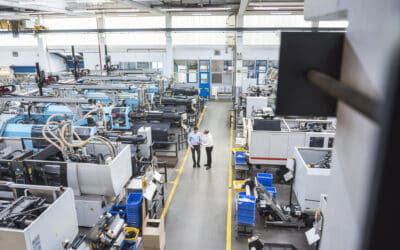TEEP (Total Effective Equipment Performance) is a key indicator for industrial companies seeking to optimize their performance. It measures the efficiency of a production system by taking into account availability, performance, and the quality of finished products. Rigorous management of TEEP helps improve profitability, reduce costs, and optimize manufacturing processes. This article provides a detailed look at the definition of TEEP, its calculation methods, and strategies for effectively optimizing it.
Understanding TEEP and Its Role in Production
Definition and Core Principles
TEEP is an indicator that reflects the overall efficiency of a production unit. It measures the overall effectiveness of equipment by taking into account availability, performance, quality, and planned downtimes, such as losses related to changeovers and adjustments, thereby offering a broader view of production losses. By adopting proactive management and using appropriate methods, manufacturers can improve their TEEP and optimize their production.
Differences Between TEEP, OEE, and OOE
TEEP is often compared to OEE (Overall Equipment Effectiveness) and OOE (Overall Operations Effectiveness). OEE measures efficiency only during the time the machine is running, while OOE takes into account scheduled downtimes. TEEP encompasses all these aspects, offering a comprehensive view of performance. A comparison table helps better understand these differences and choose the most relevant indicator based on industrial needs.
Why is TEEP a key indicator?
TEEP is a powerful tool for manufacturers seeking to optimize their production performance. It helps detect productivity losses, identify the causes of downtime, and improve resource management. By integrating TEEP into the planning and monitoring of operations, a company can reduce costs, improve quality, and better meet customer expectations while optimizing production lead times.
How is TEEP calculated?
The TEEP formula explained simply
TEEP is calculated using the following formula: TEEP = Availability x Performance x Quality x Utilization Rate. For example, if a machine runs 85% of the planned time, reaches 90% of its optimal speed, produces 95% compliant parts, and has a utilization rate of 95%, its TEEP is 69.1%.
The four components of TEEP: Availability, Performance, Quality, Utilization Rate
- Availability: represents the actual time used compared to the planned time.
- Performance: indicates the actual production speed compared to the theoretical rate.
- Quality: measures the share of compliant products out of the total production.
- Utilization Rate: is the ratio between the time actually used for production (including micro-stoppages or slowdowns) and the available time. It reflects how fully equipment is used compared to its theoretical potential.
Improving each of these factors helps optimize the overall TEEP.
Example of TEEP calculation in a company
Let’s take the case of a company operating a machine for 8 hours a day.
- The operator takes a 30-minute break, reducing the scheduled production time to 7.5 hours.
- During these 7.5 hours, a breakdown lasting 1 hour occurs. Availability is therefore: 6.5 h / 7.5 h = 86.7% (rounded)
- Performance (speed) is 95%
- Quality rate is 98%
We can then calculate OEE as follows:
OEE = 86.7% x 95% x 98% = 80.7%
Finally, if we take into account the utilization rate, which corresponds to the ratio between the scheduled production time (7.5 h) and the total available time during the day (8 h), we get:
Utilization Rate = 7.5 h / 8 h = 93.75%
The even more comprehensive indicator then becomes:
OEE x Utilization Rate = 80.7% x 93.75% = TEEP 75.6%
This example shows how TEEP helps identify specific levers to improve overall equipment performance.
Tools to measure TEEP in real time
Many software tools allow TEEP to be analyzed in real time. PerfTrak is a popular solution that provides interactive dashboards, enabling manufacturers to adjust their operations based on performance indicators. Automated tracking enables greater responsiveness and continuous optimization of the production process.
What factors influence TEEP?
Opening time vs required time
TEEP is influenced by the gap between opening time (total available time) and the actual time required for production. Poor planning or frequent interruptions can lower this rate.
Machine downtime and breakdowns
Machine failures, unscheduled maintenance, or waiting times negatively impact TEEP. Implementing a preventive maintenance plan and using real-time monitoring tools can help reduce these losses.
Quality and scrap rate
A high scrap rate reduces TEEP. Improving manufacturing processes, training operators, and integrating quality control tools help limit these losses and improve productivity.
Production rate
A production rate below the nominal rate leads to a loss of performance, even if the equipment is available and the quality is good. Such deviations may be due to incorrect machine settings, irregular raw material supply or frequent manual intervention. By analyzing production cycles and automating certain tasks, it is possible to optimize output and improve TEEP.
Why is TEEP essential for the industry?
Identify and reduce productivity losses
Total Effective Equipment Performance (TEEP) is a key indicator that allows industries to measure and improve their operational efficiency. It is based on four pillars: availability, performance, quality, and utilization rate.
Productivity losses can be caused by:
- Unplanned stops (machine breakdowns, unexpected corrective maintenance)
- Underutilization of equipment (waiting time, overly long changeovers)
- Production defects (scrap, rework, quality issues)
- The load rate (the gap between total open time and the actual planned production time, indicating a lack of utilization or inefficient planning)..
How to improve profitability with better TEEP monitoring
Accurate TEEP tracking helps optimize resources and increase profitability. Every point gained in TEEP results in more efficient production and reduced costs.
Potential financial gains include:
✅ Improved equipment utilization, reducing the need to purchase new machines,
✅ Lower maintenance costs thanks to better planning,
✅ Lower scrap rates and material losses, with a direct impact on profitability,
✅ Increased productivity with the same workforce and resources.
How to improve TEEP?
Implement real-time analysis
Monitoring TEEP in real-time helps quickly detect anomalies and take corrective action. Adopting digital tools improves responsiveness and optimizes production flows.
Automate calculations and use appropriate tools
IoT and software solutions, like PerfTrak, enable automatic collection of production data. This facilitates analysis and helps make decisions based on reliable indicators to improve profitability.
Train teams and implement best practices
Team involvement is key to maintaining a good TEEP level. Continuous training and the implementation of good production practices help improve quality, optimize tasks, and ensure a more stable production flow.
How TEEPTRAK helps you maximize your TEEP
Our tracking and optimization solutions
TEEPTRAKoffers powerful tools to optimize Total Equipment Effectiveness (TEEP) and improve industrial efficiency. Our solutions collect and analyze production data in real-time, providing companies with better visibility into their performance and improvement levers. By reducing losses, minimizing unplanned stops, and optimizing processes, our tools provide immediate value to your business.
PerfTrak: A key tool for Industry 4.0
PerfTrak is an advanced production tracking and optimization solution. It provides real-time monitoring of machine and operator performance, enabling fast and effective decision-making. With an intuitive interface and precise key performance indicators (KPIs), PerfTrak helps:
- Identify the causes of production stoppages
- Improve organization and responsiveness
- Maximize equipment throughput
- Reduce costs associated with productivity losses
Its simple and quick integration makes it an indispensable tool for businesses aiming to transition to Industry 4.0.
Calculate your ROI with our simulator
Want to estimate the impact of TEEP optimization on your business? Try our online simulator! This interactive tool allows you to:
✅ Measure potential gains
✅ Identify areas for improvement
✅ Visualize the expected return on investment
Take action now by accessing our simulator on our website and discover how TEEPTRAK can transform your industrial performance.
FAQ – Everything you need to know about TEEP
How is TEEP calculated?
TEEP is calculated by multiplying availability, performance, and quality. A detailed explanation can be found in the section on TEEP calculation.
What is the difference between TEEP and OEE?
TEEP takes into account the entire production cycle, while OEE focuses only on performance during production time. Each indicator has its own specifics and usefulness.
How to interpret a low TEEP?
A low TEEP may indicate losses in availability, performance, or quality. A thorough analysis of the causes allows for implementing appropriate solutions to improve efficiency.
What is a good TEEP for my industry?
A good TEEP depends on the industry. On average, a TEEP above 75% is considered good, while some industries require levels above 85% to stay competitive.





0 Comments